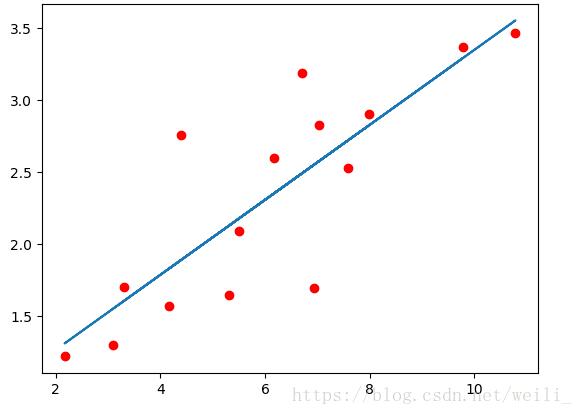本文实例为大家分享了pytorch实现线性回归以及多元回归的具体代码,供大家参考,具体内容如下
最近在学习pytorch,现在把学习的代码放在这里,下面是github链接
直接附上github代码
|
1
2
3
4
5
6
7
8
9
10
11
12
13
14
15
16
17
18
19
20
21
22
23
24
25
26
27
28
29
30
31
32
33
34
35
36
37
38
39
40
41
42
43
44
45
46
47
48
49
50
51
52
53
54
55
56
57
58
59
60
61
62
|
# 实现一个线性回归# 所有的层结构和损失函数都来自于 torch.nn# torch.optim 是一个实现各种优化算法的包,调用的时候必须是需要优化的参数传入,这些参数都必须是variable x_train = np.array([[3.3],[4.4],[5.5],[6.71],[6.93],[4.168],[9.779],[6.182],[7.59],[2.167],[7.042],[10.791],[5.313],[7.997],[3.1]],dtype=np.float32)y_train = np.array([[1.7],[2.76],[2.09],[3.19],[1.694],[1.573],[3.366],[2.596],[2.53],[1.221],[2.827],[3.465],[1.65],[2.904],[1.3]],dtype=np.float32) # 首先我们需要将array转化成tensor,因为pytorch处理的单元是tensor x_train = torch.from_numpy(x_train)y_train = torch.from_numpy(y_train) # def a simple network class linearregression(nn.module): def __init__(self): super(linearregression,self).__init__() self.linear = nn.linear(1, 1) # input and output is 2_dimension def forward(self, x): out = self.linear(x) return out if torch.cuda.is_available(): model = linearregression().cuda() #model = model.cuda()else: model = linearregression() #model = model.cuda() # 定义loss function 和 optimize funccriterion = nn.mseloss() # 均方误差作为优化函数optimizer = torch.optim.sgd(model.parameters(),lr=1e-3)num_epochs = 30000for epoch in range(num_epochs): if torch.cuda.is_available(): inputs = variable(x_train).cuda() outputs = variable(y_train).cuda() else: inputs = variable(x_train) outputs = variable(y_train) # forward out = model(inputs) loss = criterion(out,outputs) # backword optimizer.zero_grad() # 每次做反向传播之前都要进行归零梯度。不然梯度会累加在一起,造成不收敛的结果 loss.backward() optimizer.step() if (epoch +1)%20==0: print('epoch[{}/{}], loss: {:.6f}'.format(epoch+1,num_epochs,loss.data)) model.eval() # 将模型变成测试模式predict = model(variable(x_train).cuda())predict = predict.data.cpu().numpy()plt.plot(x_train.numpy(),y_train.numpy(),'ro',label = 'original data')plt.plot(x_train.numpy(),predict,label = 'fitting line')plt.show() |
结果如图所示:

多元回归:
|
1
2
3
4
5
6
7
8
9
10
11
12
13
14
15
16
17
18
19
20
21
22
23
24
25
26
27
28
29
30
31
32
33
34
35
36
37
38
39
40
41
42
43
44
45
46
47
48
49
50
51
52
53
54
55
56
57
58
59
60
61
62
63
64
65
66
67
68
69
70
71
72
73
74
75
76
77
78
79
80
81
82
83
84
85
86
87
88
89
90
91
92
93
|
# _*_encoding=utf-8_*_# pytorch 里面最基本的操作对象是tensor,pytorch 的tensor可以和numpy的ndarray相互转化。# 实现一个线性回归# 所有的层结构和损失函数都来自于 torch.nn# torch.optim 是一个实现各种优化算法的包,调用的时候必须是需要优化的参数传入,这些参数都必须是variable # 实现 y = b + w1 *x + w2 *x**2 +w3*x**3import osos.environ['cuda_device_order']="pci_bus_id"os.environ['cuda_visible_devices']='0'import torchimport numpy as npfrom torch.autograd import variableimport matplotlib.pyplot as pltfrom torch import nn # pre_processingdef make_feature(x): x = x.unsqueeze(1) # unsquenze 是为了添加维度1的,0表示第一维度,1表示第二维度,将tensor大小由3变为(3,1) return torch.cat([x ** i for i in range(1, 4)], 1) # 定义好真实的数据 def f(x): w_output = torch.tensor([0.5, 3, 2.4]).unsqueeze(1) b_output = torch.tensor([0.9]) return x.mm(w_output)+b_output[0] # 外积,矩阵乘法 # 批量处理数据def get_batch(batch_size =32): random = torch.randn(batch_size) x = make_feature(random) y = f(x) if torch.cuda.is_available(): return variable(x).cuda(),variable(y).cuda() else: return variable(x),variable(y) # def modelclass poly_model(nn.module): def __init__(self): super(poly_model,self).__init__() self.poly = nn.linear(3,1) def forward(self,input): output = self.poly(input) return output if torch.cuda.is_available(): print("sdf") model = poly_model().cuda()else: model = poly_model() # 定义损失函数和优化器criterion = nn.mseloss()optimizer = torch.optim.sgd(model.parameters(), lr=1e-3) epoch = 0while true: batch_x, batch_y = get_batch() #print(batch_x) output = model(batch_x) loss = criterion(output,batch_y) print_loss = loss.data optimizer.zero_grad() loss.backward() optimizer.step() epoch = epoch +1 if print_loss < 1e-3: print(print_loss) break model.eval()print("epoch = {}".format(epoch)) batch_x, batch_y = get_batch()predict = model(batch_x)a = predict - batch_yy = torch.sum(a)print('y = ',y)predict = predict.data.cpu().numpy()plt.plot(batch_x.cpu().numpy(),batch_y.cpu().numpy(),'ro',label = 'original data')plt.plot(batch_x.cpu().numpy(),predict,'b', ls='--',label = 'fitting line')plt.show() |
以上就是本文的全部内容,希望对大家的学习有所帮助,也希望大家多多支持服务器之家。
原文链接:https://blog.csdn.net/weili_/article/details/82959756










